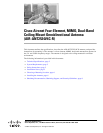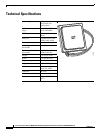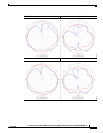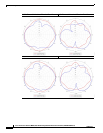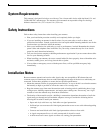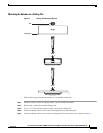
5
Cisco Aironet Four-Element, MIMO, Dual-Band Ceiling Mount Omnidirectional Antenna (AIR-ANT2524V4C-R)
78-20577-01
System Requirements
System Requirements
This antenna is designed for indoor use with any Cisco Aironet radio device with dual-band (2.4- and
5-GHz) RP-TNC antenna ports. The antenna can be mounted on suspended ceiling tiles having a
thickness between ½ in. (1.27-cm) and 1 in. (2.54-cm).
Safety Instructions
Follow these safety instructions when installing your antenna.
• Plan your installation procedure carefully and completely before you begin.
• If you are installing an antenna for the first time, for your own safety as well as others, seek
professional assistance. Consult your dealer, who can explain which mounting method to use for the
location where you intend to install the antenna.
• Select your installation site with safety, as well as performance, in mind. Remember that electric
power cables and telephone lines look alike. For your safety, assume that any line is an electric
power line until determined otherwise.
• Call your local power company or building maintenance organization if you are unsure about cables
close to your mounting location.
• When installing your antenna, do not use a metal ladder. Do dress properly: shoes with rubber soles
and heels, rubber gloves, and a long sleeved shirt or jacket.
• If an accident or emergency occurs with the power lines, call for qualified emergency help
immediately.
Installation Notes
Because antennas transmit and receive radio signals, they are susceptible to RF obstructions and
common sources of interference that can reduce throughput and range of the device to which they are
connected. Follow these guidelines to ensure the best possible performance:
• Mount the antenna to utilize its propagation characteristics. A way to do this is to orient the antenna
horizontally as high as possible at or near the center of its coverage area.
• Keep the antenna away from metal obstructions such as heating and air-conditioning ducts, large
ceiling trusses, building superstructures, and major power cabling runs. If necessary, use a rigid
conduit to lower the antenna away from these obstructions.
• The density of the materials used in a building’s construction determines the number of walls the
signal must pass through and still maintain adequate coverage. Consider the following before
choosing the location to install your antenna:
–
Paper and vinyl walls have very little affect on signal penetration.
–
Solid and pre-cast concrete walls limit signal penetration to one or two walls without degrading
coverage.
–
Concrete and wood block walls limit signal penetration to three or four walls.
–
A signal can penetrate five or six walls constructed of drywall or wood.
–
A thick metal wall causes signals to reflect off, causing poor penetration.



